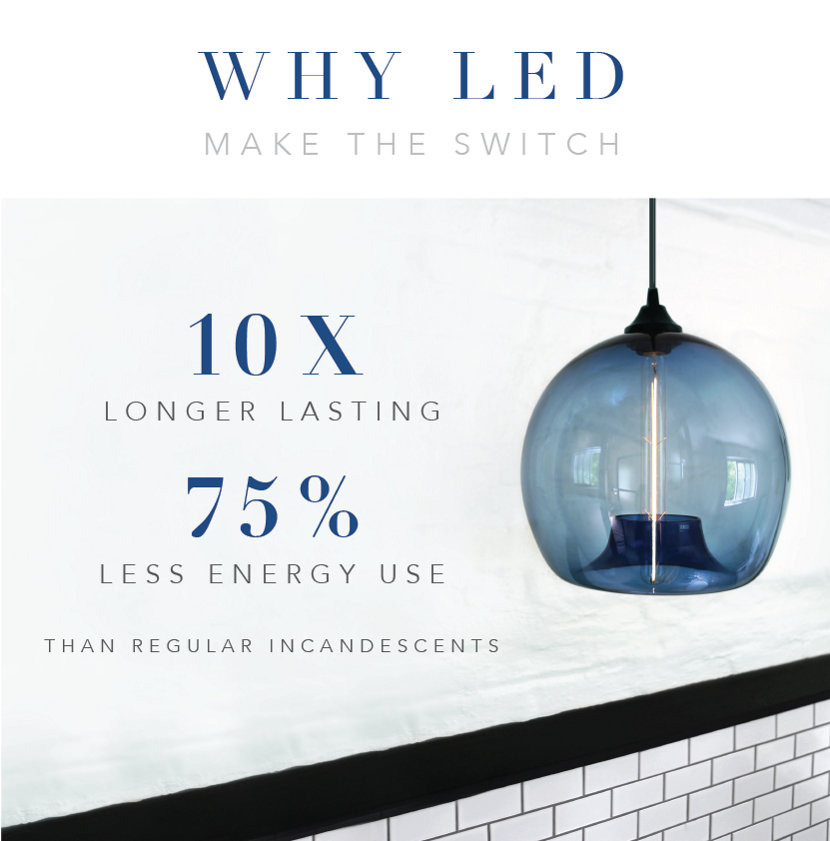Not only do LED bulbs last nearly 10-times longer than regular incandescents; they also reduce the cost of your electric bill by using 75% less energy than standard lamping options. That's why we are introducing two new LED bulb options, the LED Long Continuous Filament Bulb and the LED Long Continuous Filament Frosted Bulb. Keep reading to learn about all of the benefits of energy efficient bulbs and LED lighting.

1. LONGEVITY
The long lifetime of an LED light stands out as the number one benefit. LED bulbs and diodes can last about 25X longer than their incandescent counterparts. LEDs are different than standard lighting, as they don't burn out, but diodes will emit a lower output over a very long period of time and become less bright. You can make your bulb last even longer by installing it on a compatible dimmer.
2. ENERGY/COST EFFICIENCY
LED light bulbs use only 2-17 watts of electricity, 1/3rd to 1/30th of incandescent bulbs. The LED method of producing light uses far less energy than other lighting technologies. A light fixture with a standard 60-watt incandescent bulb consumes about 525 kWh (kilowatt-hours) of electricity in a year, but an LED bulb only uses about 65 kWh. That's about 85% more efficient than the filament method used in incandescent bulbs, which will make a big difference in your next electricity bill.
3. ECOLOGICALLY FRIENDLY
LED lights are toxic chemical free! Most fluorescent bulbs contain a multitude of materials like mercury that are dangerous for the environment. LED bulbs are also 100% recyclable! Additionally, the long life of LED bulbs can save material and production of 25 incandescent bulbs.
4. NO UV EMISSIONS
LED lights produce little infrared light and close to no UV emissions. This makes LED lighting highly suitable for goods and materials that are sensitive to heat, and are great for illumination of objects found in museums, art galleries, or archaeological sites.
5. DURABLE QUALITY
LEDs are extremely durable and resistant to shock, vibrations, and external impacts, making them great for rough conditions such as exposure to weather, construction and manufacturing sites.
6. OPERATIONAL IN EXTREMELY COLD OR HOT TEMPERATURES
LEDs are ideal for operation under cold and low outdoor temperature settings and are excellent for winter settings or freezer rooms. Low temperatures affect the performance of fluorescent bulbs.
7. LOW-VOLTAGE
Low-voltage power supply also makes LED lighting easy to use in outdoor settings by connecting an external solar-energy source — this is a big advantage for using LED technology in remote or rural areas.
8. LIGHT DISPERSAL
LED is designed to focus its light and can be directed to a specific location without the use of an external reflector, achieving a higher application efficiency than conventional lighting.
9. DESIGN FLEXIBILITY
Individual LEDs can be dimmed, resulting in a dynamic control of light, color and distribution. LEDs can be combined in any shape to produce highly efficient illumination.
10. INSTANT LIGHTING & FREQUENT SWITCHING
LED lights brighten up immediately when powered on, which is a great advantage for traffic and signal lights. Also, LED lights can switched off and on frequently without affecting the LED’s lifetime. Traditional lighting may take several seconds to reach full brightness, and frequent on/off switching reduces life expectancy.
We just made it easier than ever to find the perfect lighting accessories. Sign up now to have the LED & CFL Product Guide sent right to your inbox! This handy guide includes lamping basics and product information for all of our LED & CFL options.
